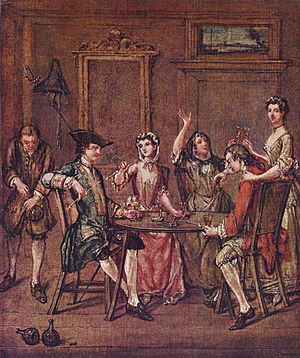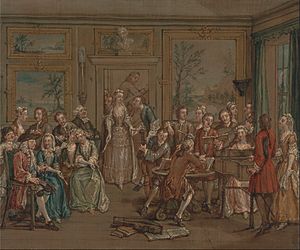Marcellus Laroon the Younger facts for kids

Marcellus Laroon the Younger (born April 2, 1679 – died June 1, 1772) was an English artist. He was a painter and also a draughtsman, meaning he was skilled at drawing. He came from a French family. Laroon was known for painting scenes of everyday life. He often spent time with actors and other artists in the Covent Garden area of London, and he painted what he saw there. A person who knew him, George Vertue, said that Laroon painted mostly for fun, not just to make money.
Contents
Who Was Marcellus Laroon the Younger?
Marcellus Laroon the Younger was an important artist from the 1700s. He is remembered for his unique paintings that show people doing ordinary things. These types of paintings are called "genre scenes." He captured what life was like in London during his time.
Early Life and Family
Maroon was born in a place called Chiswick in Middlesex, England. His father was also named Marcellus Laroon. His dad was a painter and an engraver, which means he made pictures by carving designs into metal. Laroon the Elder was born in the Netherlands. His own father, Marcellus Lauron, was a French artist. Laroon the Elder brought his son, Marcellus the Younger, to England when he was a child. Because of this, Marcellus the Younger spent his whole life and career in England.
An Artist and a Soldier
In 1707, Marcellus Laroon the Younger joined the army. He fought in different places like Flanders, Spain, and Scotland. During a break from the army, around 1712 to 1715, he continued his art training. He joined a group called the Rose and Crown Club in London. He also studied at an art school run by a famous painter named Godfrey Kneller. This school was called the Academy of Painting and Drawing.
Most of Laroon's paintings were created after he left the army. He retired in 1732 with the rank of captain.
Later Years and Legacy
In the late 1750s, Laroon moved to Oxford. He lived there until he passed away in 1772. His paintings give us a glimpse into the social life of 18th-century England. They show us how people lived, dressed, and interacted during that time.


